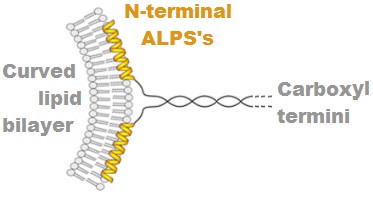Amphipathic Lipid Packing Sensor Motifs on:
[Wikipedia]
[Google]
[Amazon]
Amphipathic Lipid Packing Sensor (ALPS) motifs were first identified in 2005 in  The curving of a
The curving of a
ARFGAP1
ADP-ribosylation factor GTPase-activating protein 1 is an enzyme that in humans is encoded by the ''ARFGAP1'' gene. Two transcript variants encoding different isoforms have been found for this gene.
Function
The protein encoded by this gene ...
and have been reviewed.
 The curving of a
The curving of a phospholipid
Phospholipids, are a class of lipids whose molecule has a hydrophilic "head" containing a phosphate group and two hydrophobic "tails" derived from fatty acids, joined by an alcohol residue (usually a glycerol molecule). Marine phospholipids typ ...
bilayer
A bilayer is a double layer of closely packed atoms or molecules.
The properties of bilayers are often studied in condensed matter physics, particularly in the context of semiconductor devices, where two distinct materials are united to form junc ...
, for example into a liposome, causes disturbances to the packing of the lipids on the side of the bilayer that has the larger surface area (the outside of a liposome for example). The less "ordered" or "looser" packing of the lipids is recognized by ALPS motifs.
ALPS motifs are 20 to 40 amino acid long portions of proteins
Proteins are large biomolecules and macromolecules that comprise one or more long chains of amino acid residues. Proteins perform a vast array of functions within organisms, including catalysing metabolic reactions, DNA replication, respo ...
that have important collections of types of amino acid residues. Bulky hydrophobic amino acid residues, such as Phenylalanine
Phenylalanine (symbol Phe or F) is an essential α-amino acid with the formula . It can be viewed as a benzyl group substituted for the methyl group of alanine, or a phenyl group in place of a terminal hydrogen of alanine. This essential amino a ...
, Leucine, and Tryptophan are present every 3 or 4 positions, with many polar but uncharged amino acid residues such as Glycine, Serine
Serine (symbol Ser or S) is an α-amino acid that is used in the biosynthesis of proteins. It contains an α-amino group (which is in the protonated − form under biological conditions), a carboxyl group (which is in the deprotonated − form un ...
and Threonine
Threonine (symbol Thr or T) is an amino acid that is used in the biosynthesis of proteins. It contains an α-amino group (which is in the protonated −NH form under biological conditions), a carboxyl group (which is in the deprotonated −COO� ...
between. The ALPS is unstructured in solution but folds as an alpha helix
The alpha helix (α-helix) is a common motif in the secondary structure of proteins and is a right hand-helix conformation in which every backbone N−H group hydrogen bonds to the backbone C=O group of the amino acid located four residues e ...
when associated with the membrane bilayer, such that the hydrophobic residues insert between loosely packed lipids and the polar residues point toward the aqueous cytoplasm.
References
{{reflist Membrane biology Molecular biology Proteins es:Motivo estructural ALPS